Why were ancient people interested in astronomy![]()
Key points: How the phases of the moon, the seasons, and eclipses work
Ancient man had much darker skies and was much more familiar with events in nature than we are. Here is a picture of the dark sky from Mt. Graham, pretty much what would have been seen any clear night anywhere in ancient times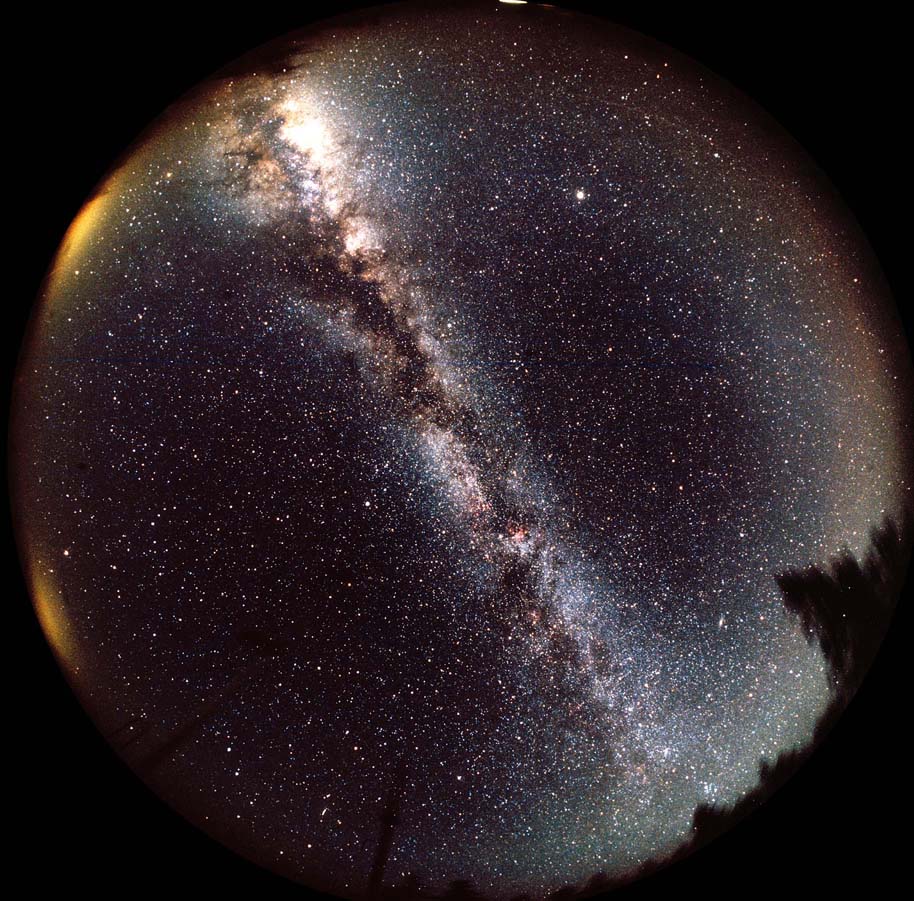 How do the motions of planets, the
moon, and the earth affect everyday lives
How do the motions of planets, the
moon, and the earth affect everyday livesEvery day:
But note that
- the period of time that the sun is above the horizon is not always the same
- the sun is higher in the sky at noon during some parts of the year
- the exact point along the horizon at which the Sun rises or sets varies throughout the year
Every month:
 (Thanks
to Antonio Cidadao http://www.astrosurf.com/cidadao/animations.htm) (Thanks
to Antonio Cidadao http://www.astrosurf.com/cidadao/animations.htm)
|
||||||
|
More or less, the moon’s phases go through the same pattern every 29-30 days. See http://www.calvin.edu/~lmolnar/moon/ for more detailed examples.
Every year:The collection of constellations that the sun moves across during the course of the year is called the zodiac. The sun’s path across the stars is call the ecliptic.
On top of these complexities, from time to time there is an eclipse of the moon, a shower of meteors, appearance of a comet, or very rarely the sun is eclipsed.
How can we explain all of these observations?
We now know that
1) Rotation of the earth causes the diurnal motion of the sun and stars.
2) Motion of the earth around the sun causes the sun to appear to move and changes which stars are visible at night.
The third point needs a bit more explanation:
 |
Here, we watch the earth go around the sun (highly not to scale!). Its axis always points the same way, somewhere way up to the right. Thus, when it is to the left of the sun in this animation, it points the northern hemisphere toward the sun and it is summer there. The south is pointed away, and it is winter there. When it is to the right of the sun, it points the southern hemisphere toward the sun and it is summer there (and winter in the north). The "solstices" are when the hemispheres are pointed as close or as far away from the sun as possible, and the "equinoxes" are exactly in between.Thus, the "summer solstice," on or about June 22, is when the sun passes closest to directly overhead in northern areas, and the "winter solstice", on or about December 22, when its highest point on the sky (that is, at noon) is as low as possible. The equinoxes are on or about March 22 and September 22. (animation by G. Rieke, Earth views from The Living Earth, http://www.fourmilab.ch/) |
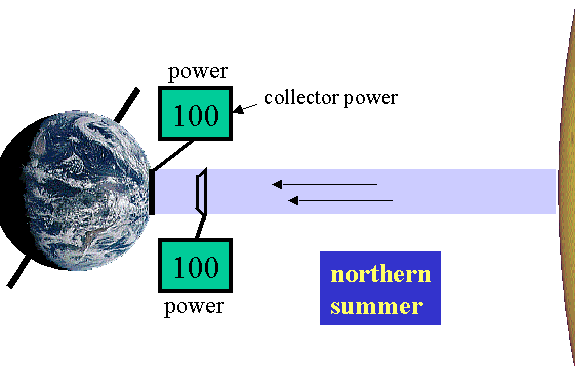
|
The change in seasons results from the change in the power received at the ground depending on how high the sun goes overhead. This animation (by G. Rieke) shows the change in power received on an area of fixed size in the summer and the winter. In the winter, the area is tilted away relative to the beam of sunlight, causing less total light to strike it (think about the arctic circle, which is the spot where the surface of the earth is tilted to be edge-on to the sun at the deepest point of winter - any energy reaching the ground at the arctic circle (and within it) must be carried there by winds in the atmosphere from regions heated directly). (animation by G. Rieke) |
Another way to think of seasons is to imagine you are at the sun, looking at the earth. Regions you can't see can't receive any sunlight, while regions that are tilted toward you so they are easy to see will receive a lot.
| The progression for northern Europe is shown below, with the earth as
viewed from the sun to the right and an illustrative painting from Pieter Brueghel's cycle
of the months to the left (for Spring, we had to substitute "The Fall of
Icarus," since the cycle painting is lost). See how much the view of Europe, as seen
from the sun, changes as the earth goes around on its orbit! When it is winter, northern
Europe is way up where light from the sun can hardly get to it, whereas in the summer it
has a straight shot |
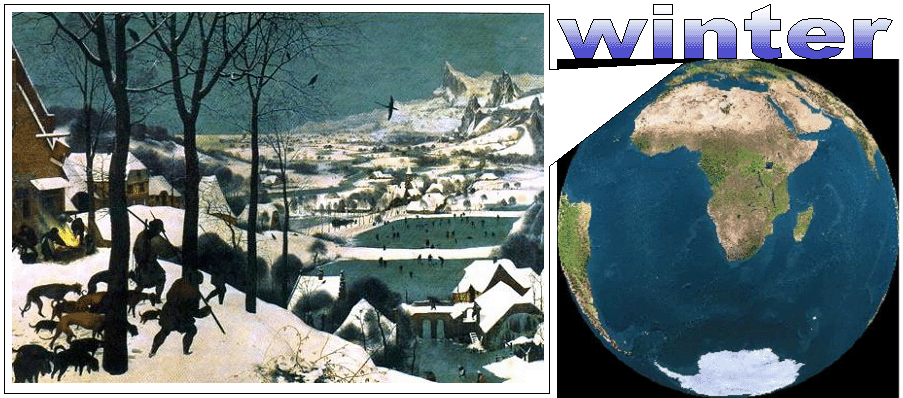 |
| Behavior of the Moon
The changing appearance of the moon
over a monthly cycle is due to the Moon’s orbital motion around the Earth coupled with the relatively great distance
of the Sun Here is how it works. The side of the moon that is toward the sun is the one that is lit up (naturally!). As the moon orbits, we see more or less of this side, depending on where it is on the orbit. (By G. Rieke. Thanks also to Antonio Cidadao) |
 |
Some summary points about phases of the moon:
EclipsesEclipses caused great awe and fear in ancient times, as shown by the quotation to the right. In fact they are just the consequence of the earth, sun, and moon all lining up together and the earth and moon casting shadows on each other. |
"Nothing is strange, nothing impossible Nor marvellous, since Zeus the father of gods Brought night to midday when he hid the light Of the shining sun. Grim fear has smitten us, And anything can happen to mankind. Let no man marvel if he sees the flocks Yield up their grassy pasture to the dolphins And seek the salty billows of the deep, Grown dearer to them than their native meadows, |
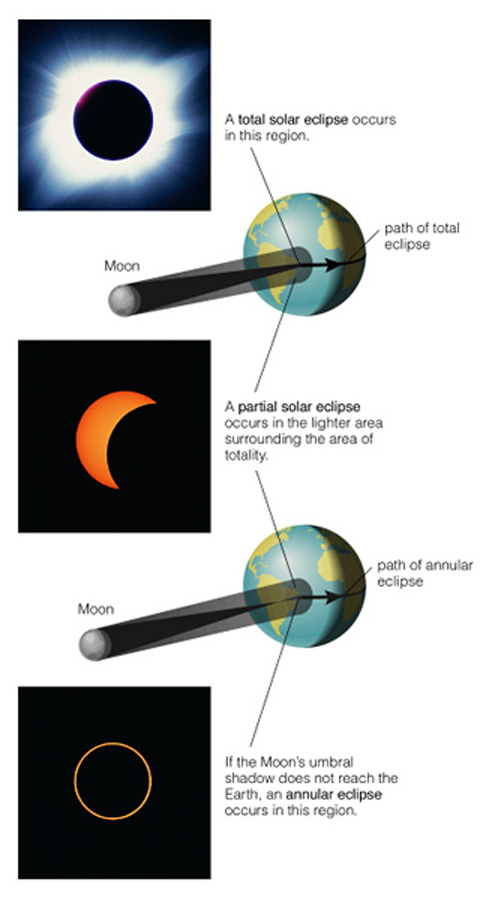 |
If the moon is between the earth and the sun, we
have a solar eclipse which is visible along a narrow region of the earth’s surface
where the moon’s shadow hits the earth.
The appearance of the eclipse depends on the exact position of the moon on its orbit, involving both whether the moon blocks the sun exactly ("totality") and also how far it is from the earth. (From The Essential Cosmic Perspective, Bennett et al.) |
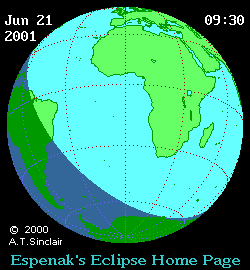 |
To the left is how the shadow passes over the earth. (From F. Espenak via Mreclipse.com, http://www.mreclipse.com/TSE99reports/image/T99video1.gif) Below is a movie of the real thing observed from a satellite:
from the European Organization for the Exploitation of Meteorological Satellites, http://www.eumetsat.de/
|
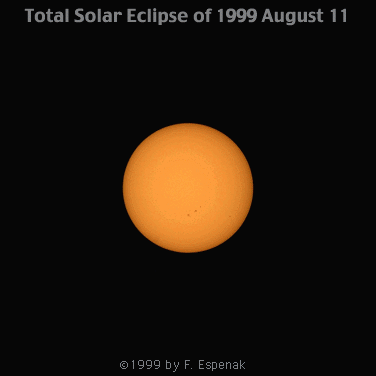 |
and here is how the eclipse looks as viewed from an
optimum spot, in the path of "totality". (From F. Espenak, http://sunearth.gsfc.nasa.gov/eclipse/TSE2001/T01animate.html) Because the moon has to be between the earth and the sun, a solar eclipse can only occur at new moon. It can only be seen at the specific spot where the moon casts a shadow on the earth. |
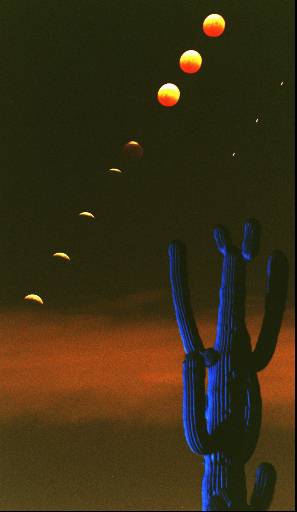 |
If the earth is between the sun and the moon
(full moon), a lunar eclipse can occur, where the full moon is darkened by the
earth’s shadow. Everyone on the nighttime side of Earth can see a lunar eclipse.
(Thanks to Antonio Cidadao http://www.astrosurf.com/cidadao/animations.htm) |
| Why aren’t there eclipses every month? Because the moon’s orbit is tilted by 5 degrees with respect to the plane defined by the earth and the sun, the shadows of Moon or Earth may miss the other body. (Illustration by G. Rieke, after N. Strobel) |

Only when the moon is simultaneously either new or full and passing through the plane of the earth’s orbit around the Sun do eclipses occur. (From Chaisson & McMillan, Astronomy Today)

Test your understanding before going on![]()

Entrance to the Sun Temple, Machu Picchu, from Windows to the Universe, http://www.windows.ucar.edu/ |
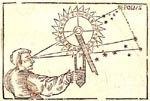
Observing with a "nocturnal," from http://www.math.nus.edu.sg/aslaksen/teaching/heavenly.shtml |
|
Click to return to syllabus |
||
| Click to go to Scales in the Universe | hypertext |
Click for Beginnings of Astronomy |